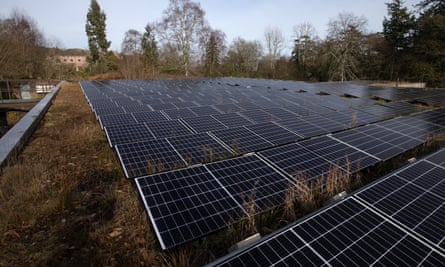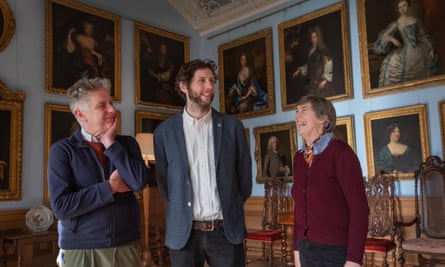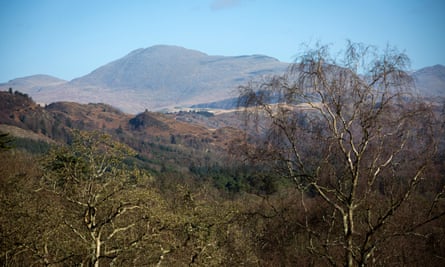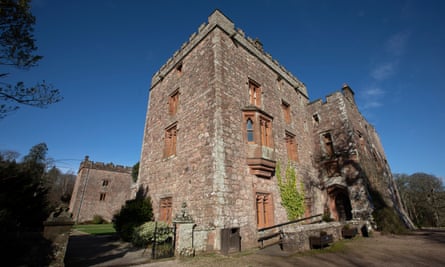[ad_1]
In 1990, the year Ewan Frost-Pennington was born, the final bears left Muncaster Castle in the westernmost corner of the Lake District. Winnie, an Asiatic black bear, departed Cumbria for Dudley zoo, along with Inca, her daughter, and her sister, Gretel.
Three decades later, the bear pit has now been covered over with a solar farm. It is the brainchild of Frost-Pennington, the heir to the 800-year-old pink granite fortress, as he tries to make Muncaster the first carbon-zero castle in the UK.
This time last year, the 32-year-old was living in San Francisco and working as a renewable energy consultant. Now he is earning 25% of his corporate salary and is quartered in a 14th-century tower with a secret passageway, surrounded by his grandparents’ old furniture.
His new job as Muncaster’s operations director is to figure out a way to make the 800-hectare (2,000-acre) estate not just sustainable but also attractive to a younger audience.
Its isolated location, an hour off the M6 and two hours from Manchester airport, can make it difficult to lure in foreign tourists. Frost-Pennington – who prefers the term custodian rather than heir – must be creative. In April he will be hosting Muncaster’s first drag show, Dragcaster, as well as the inaugural Sausage Fest. This summer will see the return of Krankenhaus, a music festival curated by Sea Power (formerly British Sea Power), and Race the Tide, a 10km obstacle race along – and in – the tidal River Esk.

Living in a remote castle with his parents has its challenges for a young, single man (his US girlfriend who came with him from California did not stay). “To be honest, I’m finding it a bit too castle-y,” he said, giving the Guardian a tour last week. “It’s like I’m wearing the clothes of my ancestors. It feels a bit itchy.”
The castle’s grade-I listing means he cannot put up his own pictures and it is freezing most of the time. The solar panels and ground source heat pump now contribute at least 60% of the building’s heating needs, but Frost-Pennington’s parents insist they only heat the rooms the public. The family like to claim it is Britain’s most haunted castle – they get their biggest audience around Halloween, for an event they call Scarecaster – and there is a definite creepiness behind the scenes, with child mannequins lurking behind corners and dusty cabinets of toy soldiers.

Out of his bedroom window, Frost-Pennington can see the fells of Eskdale, with Scafell Pike, England’s highest mountain, lurking in the distance. The Victorian art critic John Ruskin described the view from Muncaster as “the gateway to paradise”. But Frost-Pennington is just as keen to point out the 0.8-mile (1.3km) trench he had dug to make way for the castle’s heat pump.
Before Frost-Pennington decided to return, his younger sister, Isla, had a go at running Muncaster. She quit after falling in love with a farmer from Lancashire – her nearest Tinder match, an hour and a half away. Their other sibling, Fraser, is in the armed forces.

Built to keep out the Scots, Muncaster Castle has been in the family for at least 800 years. Frost-Pennington’s mother, Iona, took over aged 23. Her parents literally sold the family silver in order to keep the castle, and flogged off most of the original 12,000-hectare estate to keep afloat.
Growing up in a castle with 31 hectares of gardens and its own owl sanctuary could be fun. Hide-and-seek games were legendary, though “strict boundaries had to be enforced otherwise you’d never find anyone”, says Frost-Pennington.
The family are asset-rich but cash poor: sometimes the tourism business makes less than £10,000 annual profit. Iona Frost-Pennington, who recently painted the huge drawing room herself after the decorator cancelled, pays herself just £3,000 a year.

Her son Ewan learned at a young age not to tell other children where he lived – “otherwise you become Castle Boy”. He has now accepted his role, while acknowledging: “There is no way of saying ‘I live in a castle’ without sounding like an idiot.” He knows he is what is now called a nepo baby – “of course I’m here through pure nepotism” – but says that for his own ego he wants to prove he can increase visitor numbers through ecotourism.
There is a certain eccentricity to the Frost-Penningtons. Iona met Ewan’s dad, Peter, at a party. “I hear you’re a vet,” she told him. “Can you castrate my bears?” As well as owls and vultures, the family always has a black cat – the family symbol on the castle’s flag and coat of arms.
Though he will one day inherit the castle, Iona has yet to allow her eldest son to touch the family’s most-prized possession. In the 1460s one of their ancestors offered sanctuary to Henry VI as the monarch fled from defeat in the War of the Roses. Henry left a Venetian glass bowl as a thank you gift along with a prophecy: “As long as this bowl remains unriven, Penningtons from Muncaster never shall be driven.”
Waving the Guardian goodbye, Frost-Pennington says he is looking forward to the article: “I just hope it doesn’t turn out to be a story of the son who ruined everything.”
[ad_2]
READ SOURCE


